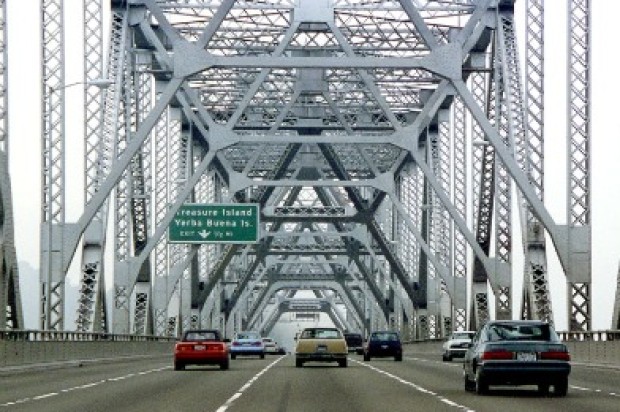
Plans to demolish the largest pier in the old eastern span of the Bay Bridge using explosives took another step forward today as a bay regulatory commission unanimously granted Caltrans a permit for the project.
The San Francisco Bay Conservation and Development Commission approval was one of the final permits necessary — the last being from the U.S. Army Corps of Engineers — for Caltrans to move forward with the implosion on Nov. 10, Caltrans engineer Brian Maroney said at today’s commission meeting in San Francisco.
Maroney elaborated on the plan to take down Pier E3, a 268-foot chunk of concrete set 165 feet in the Bay mud, in six seconds using nearly 400 small explosives. The concrete debris would, in theory, fall into 28 hollow cells within the pier and become entombed at the bottom of the Bay.
To keep the debris from spreading, crews would surround it with a boom and raise a “bubble curtain” of compressed air surrounding the pier.
Ian Wren, a staff scientist with environmental watchdog group Baykeeper, has expressed skepticism with that aspect of the plan and whether it would be able to adequately contain the concrete debris, saying that Caltrans is seeking a cheaper and faster option at the expense of the environment.
Wren did not speak at today’s meeting to elaborate on those concerns and there were no other speakers opposing the plan.
Caltrans maintains that the plan is not only the fastest and cheapest option, but the most environmentally sound as well. To mechanically remove the pier would necessitate driving hundreds of piles into the mud, building a dam around the pier and removing the surrounding water. Dismantling it would take months.
“Just because something goes faster and cheaper doesn’t mean it’s lower quality for the environment,” Maroney said.
Some material will probably scatter in the implosion, requiring between a week and a month to clean up, but overall the bubble curtain is expected to direct the debris into the deep, hollow cells of the underground portion of the pier, Maroney said.
The other major environmental concern is how the blast will affect wildlife, both through immediate injury and through any behavioral changes caused by the sound.
To mitigate that impact, Caltrans chose November for the implosion, the time when there will be the least wildlife in the area. Monitors will watch for birds and mammals, and if any are spotted the implosion will be postponed.
The largest buffer necessary will be over a mile for any elephant seals, but Caltrans environmental coordinator Stefan Galvez said it is very unlikely there will be any elephant seals in the area at that time.
Scientists with the Marine Mammal Center will be standing by to lend any assistance necessary, Galvez said.
If the implosion goes according to plan, Maroney said Caltrans would likely seek to demolish the remaining 21 smaller piers the same way.
Caltrans is required to report back to the commission after the implosion and will need to obtain permits for any future use of explosives.
“This is a new and untested technique,” commission chair R. Zachary Wasserman said shortly before the group approved the permit. “If we were unwilling to try new techniques… we would be a much poorer and more backwards civilization.”
Scott Morris, Bay City News









